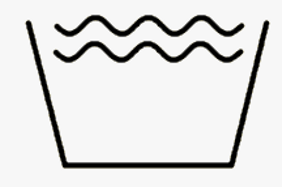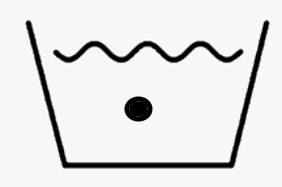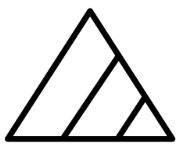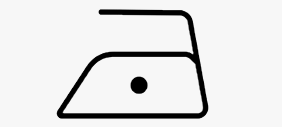Ever stared at those little icons on your clothing tag and thought, What do these even mean? Don’t worry, you’re not alone. Laundry symbols can feel like a secret language, but once you crack the code, they’ll become your best friend for keeping your clothes looking fresh and fabulous. Let’s break them down together in a fun, easy way!
Washing Symbols: How to Get It Clean
Washing symbols are small icons on care labels that tell you how to clean your clothes. Think of them as laundry instructions in picture form. They give details about water temperature, washing methods, and even whether certain items need special care.
When you follow these instructions, your clothes last longer and look better. If you don’t? Well, you might end up with a shrunken sweater or discolored shirt. Let’s break down these symbols step by step.
Common Washing Symbols and What They Mean
1. The Basic Washing Tub
The washing tub symbol is your go-to for figuring out how to wash a garment. It looks like a bucket of water and tells you if and how you can machine wash the item.

Plain tub
Machine wash with no restrictions.

Tub with one line underneath
Use a gentle or permanent press cycle. This reduces agitation and spinning, ideal for preventing wrinkles or stretching.

Tub with two lines underneath
Delicate cycle only. Perfect for fabrics like silk, lace, or chiffon.

Tub with two lines underneath
Very Delicate cycle only.

Tub with a hand inside
Hand wash only. Be gentle! This is common for delicate fabrics or items with embellishments.

Tub with an X over it
Do not wash in water. This item likely needs dry cleaning.

Tub with waves above it
Use a gentle wash. This could mean slower spin cycles or lower water agitation.

Tub with a dot and an X
Do not use spin cycles. This is common for delicate fabrics like wool that could lose their shape.
2. Washing Temperature Symbols
These symbols help you choose the right water temperature. Too hot, and you could damage the fabric. Too cold, and stains might not come out.

Number inside the tub (e.g., 30, 40, 50)
Maximum washing temperature in Celsius. For example, “40” means 40°C

One Dot inside the tub
Cold water (around 30°C). Best for delicate items or dark colors.

2 Dots inside the tub
Warm water (around 40°C). Ideal for most everyday clothes.

3 Dots inside the tub
Hot water (50°C or higher). Great for whites and heavily soiled fabrics, but avoid for delicate materials.
3. Pro Tips for Following Washing Symbols
- Keep a Cheat Sheet: Print out a guide to washing symbols and keep it near your washer.
- Sort Smartly: Always sort clothes by fabric type, washing instructions, and color before starting the machine.
- Invest in a Delicates Bag: For items marked with “hand wash only,” a mesh laundry bag can protect them during a gentle machine wash.
- Cold is Safe: When in doubt, choose a cold wash. It’s less likely to damage fabrics or colors.
Bleaching Symbols: Can You Brighten It?
Bleach can work wonders on stained whites or brighten dingy clothes, but it’s not always safe for every fabric. Using bleach the wrong way can lead to disaster—think discolored patches, holes in fabric, or worse, a completely ruined garment. That’s where bleaching symbols on your clothing labels come in. They’re like a cheat sheet that tells you whether it’s okay to use bleach—or whether it’s a big no-no. Let’s dive into these symbols and what they mean, so you can keep your laundry bright without accidentally ruining your favorite pieces!

The Triangle (Bleach It Freely!)
This means your garment is bleach-friendly, and you can use any type of bleach—chlorine or non-chlorine—without worry.

Triangle with Two Diagonal Lines (Use Non-Chlorine Bleach Only)
It’s a heads-up that your clothes can handle non-chlorine bleach only. Non-chlorine bleach is gentler and color-safe, making it ideal for brightening colors or delicate fabrics without damage.

Crossed-Out Triangle (No Bleach Allowed!)
If the triangle has an X over it, back away from the bleach bottle! This symbol means that bleaching, in any form, is a no-go. Bleach could weaken the fibers, fade colors, or cause holes in the fabric.
How to Use Bleach Safely (When Permitted)
Bleach can be powerful stuff, so even when the symbols say it’s okay, it’s smart to proceed carefully:
- Dilute It: Always mix bleach with water before applying it to clothes. Using it straight can be too harsh.
- Spot Test: Test a small, hidden area of the garment first to make sure the bleach won’t damage it.
- Follow Directions: Stick to the bleach-to-water ratios listed on the bottle.
- Use Cold Water: Hot water can cause bleach to evaporate quickly, reducing its effectiveness.
Tips for Bleach Alternatives
If the label says no bleach, don’t worry—you still have options!
- Baking Soda: A natural brightener that’s safe for whites and colors. Add 1/2 cup to your wash.
- White Vinegar: Great for removing odors and brightening whites. Add 1/2 cup during the rinse cycle.
- Oxygen Bleach: This is a safer, non-chlorine alternative that’s effective on stains and safe for most fabrics.
Drying Symbols: Let’s Get It Dry
Drying clothes might seem straightforward—toss them in the dryer, hit start, and call it a day. But not all fabrics can handle the same drying process. That’s where drying symbols on your clothing tags come in. These little icons tell you exactly how to dry your clothes without shrinking, stretching, or ruining them.
Ready to become a drying expert? Let’s break it all down in a fun, easy way!
1. Square with a Circle (Tumble Dry)
This is the most common drying symbol. If you see it, your garment can go in the dryer. But there are a few variations:

Empty circle inside the square
Use any heat setting you want. Your clothes are tough enough to handle it.

One dot in the circle
Low heat only. Great for delicate and synthetic fabrics.

Two dots in the circle
Medium heat. Perfect for everyday items like t-shirts or jeans.

Three dots in the circle
High heat. Best for towels, sturdy fabrics, and items that need a faster dry.

Circle with an X over it
Do not tumble dry. This means the fabric is too delicate for the dryer and should be air-dried instead.

Circle inside a square and a single bar underneath
This normally means a drying cycle with less heat and lower spin speeds.

Circle inside a square and two bars underneath
This normally means selecting a delicate cycle with even less heat and lower spin speeds.

Solid circle inside a square
You can tumble dry the garment but do not apply heat.
2. Square with Lines (Air Drying)
If you see a square with lines, it means the garment needs to air dry. There are a few variations here too:

Square with a line at the top
Line dry. Hang the item on a clothesline or drying rack.

One horizontal line inside the square
Lay the item flat to dry. This prevents stretching, especially for heavy fabrics like wool sweaters.

Three vertical lines inside the square
Drip dry. Hang the garment up and let the water drip off naturally. Great for lightweight fabrics like silk or chiffon.

Diagonal lines in the top corner of the square
Dry in the shade. This is perfect for bright-colored clothes that could fade in direct sunlight.
3. Pro Tips for Following Drying Symbols
- Don’t Overload the Dryer: Even if your clothes are dryer-safe, overloading can lead to uneven drying and wrinkles.
- Check Before You Dry: If the label says “air dry only,” resist the temptation to throw it in the dryer, even for a quick fix!
- Invest in a Drying Rack: For clothes that need air drying, a drying rack is a lifesaver. It keeps everything neat and wrinkle-free.
- Shake It Out: Before air drying, give your clothes a good shake. This helps them dry faster and reduces wrinkles.
Ironing Symbols: Smooth Things Out
Ironing can be a lifesaver when you want to look polished and professional, but not all fabrics love the heat. That’s where ironing symbols come into play. These tiny icons on your clothing labels are there to guide you on how to iron safely—so you can smooth out wrinkles without burning holes or damaging delicate fabrics.
Let’s decode these symbols together and make ironing a breeze!

Plain iron
Good news—you can iron this item! Just check for dots (explained here) to know what heat setting to use.

Iron with an X
Do not iron. This fabric can’t handle heat, so skip the iron altogether. Think materials like leather, plastic, or certain synthetics.

1 Dot (Low Heat) on The iron
Use a cool setting, ideal for delicate fabrics like silk, nylon, or polyester. Too much heat could melt these materials!

2 Dots (Medium Heat) on the iron
Perfect for wool or synthetic blends. Be cautious, as too much heat can still cause damage.

3 Dots (High Heat) on the iron
Safe for sturdy fabrics like cotton or linen. These materials can handle more heat, so feel free to crank it up.

Iron with steam coming out of the bottom
Steam ironing is safe. Use it to tackle stubborn wrinkles.

Iron with steam crossed out
No steam allowed. Stick to dry ironing to avoid water spots or damage.

Iron with steam crossed out
No steam allowed. Stick to dry ironing to avoid water spots or damage.
How to Follow Ironing Symbols
- Start Low: When ironing multiple fabrics, begin with the lowest heat setting and work your way up.
- Use a Pressing Cloth: For delicate fabrics, place a thin cloth (like a cotton handkerchief) between the iron and the garment to prevent direct heat damage.
- Test a Hidden Spot: Unsure about the fabric? Test your iron on an inconspicuous area before tackling the whole garment.
- Avoid Printed Designs: Iron printed logos or designs inside-out to prevent cracking or melting.
Pro Tips for Wrinkle-Free Clothes
- Invest in a Steamer: For fabrics that say “do not iron,” a steamer is a gentle, heat-free option.
- Iron While Damp: For sturdy fabrics like cotton, ironing while the garment is slightly damp makes wrinkle removal easier.
- Keep It Moving: Never leave the iron in one spot for too long to avoid scorch marks.
Keep a reference chart near your laundry area, or print one for easy access when deciphering labels. Once you familiarize yourself with these symbols, you’ll extend the lifespan of your clothing and keep them looking their best!


